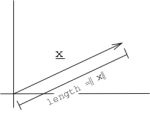15.3: Normas
- Page ID
- 86597
\( \newcommand{\vecs}[1]{\overset { \scriptstyle \rightharpoonup} {\mathbf{#1}} } \)
\( \newcommand{\vecd}[1]{\overset{-\!-\!\rightharpoonup}{\vphantom{a}\smash {#1}}} \)
\( \newcommand{\id}{\mathrm{id}}\) \( \newcommand{\Span}{\mathrm{span}}\)
( \newcommand{\kernel}{\mathrm{null}\,}\) \( \newcommand{\range}{\mathrm{range}\,}\)
\( \newcommand{\RealPart}{\mathrm{Re}}\) \( \newcommand{\ImaginaryPart}{\mathrm{Im}}\)
\( \newcommand{\Argument}{\mathrm{Arg}}\) \( \newcommand{\norm}[1]{\| #1 \|}\)
\( \newcommand{\inner}[2]{\langle #1, #2 \rangle}\)
\( \newcommand{\Span}{\mathrm{span}}\)
\( \newcommand{\id}{\mathrm{id}}\)
\( \newcommand{\Span}{\mathrm{span}}\)
\( \newcommand{\kernel}{\mathrm{null}\,}\)
\( \newcommand{\range}{\mathrm{range}\,}\)
\( \newcommand{\RealPart}{\mathrm{Re}}\)
\( \newcommand{\ImaginaryPart}{\mathrm{Im}}\)
\( \newcommand{\Argument}{\mathrm{Arg}}\)
\( \newcommand{\norm}[1]{\| #1 \|}\)
\( \newcommand{\inner}[2]{\langle #1, #2 \rangle}\)
\( \newcommand{\Span}{\mathrm{span}}\) \( \newcommand{\AA}{\unicode[.8,0]{x212B}}\)
\( \newcommand{\vectorA}[1]{\vec{#1}} % arrow\)
\( \newcommand{\vectorAt}[1]{\vec{\text{#1}}} % arrow\)
\( \newcommand{\vectorB}[1]{\overset { \scriptstyle \rightharpoonup} {\mathbf{#1}} } \)
\( \newcommand{\vectorC}[1]{\textbf{#1}} \)
\( \newcommand{\vectorD}[1]{\overrightarrow{#1}} \)
\( \newcommand{\vectorDt}[1]{\overrightarrow{\text{#1}}} \)
\( \newcommand{\vectE}[1]{\overset{-\!-\!\rightharpoonup}{\vphantom{a}\smash{\mathbf {#1}}}} \)
\( \newcommand{\vecs}[1]{\overset { \scriptstyle \rightharpoonup} {\mathbf{#1}} } \)
\( \newcommand{\vecd}[1]{\overset{-\!-\!\rightharpoonup}{\vphantom{a}\smash {#1}}} \)
\(\newcommand{\avec}{\mathbf a}\) \(\newcommand{\bvec}{\mathbf b}\) \(\newcommand{\cvec}{\mathbf c}\) \(\newcommand{\dvec}{\mathbf d}\) \(\newcommand{\dtil}{\widetilde{\mathbf d}}\) \(\newcommand{\evec}{\mathbf e}\) \(\newcommand{\fvec}{\mathbf f}\) \(\newcommand{\nvec}{\mathbf n}\) \(\newcommand{\pvec}{\mathbf p}\) \(\newcommand{\qvec}{\mathbf q}\) \(\newcommand{\svec}{\mathbf s}\) \(\newcommand{\tvec}{\mathbf t}\) \(\newcommand{\uvec}{\mathbf u}\) \(\newcommand{\vvec}{\mathbf v}\) \(\newcommand{\wvec}{\mathbf w}\) \(\newcommand{\xvec}{\mathbf x}\) \(\newcommand{\yvec}{\mathbf y}\) \(\newcommand{\zvec}{\mathbf z}\) \(\newcommand{\rvec}{\mathbf r}\) \(\newcommand{\mvec}{\mathbf m}\) \(\newcommand{\zerovec}{\mathbf 0}\) \(\newcommand{\onevec}{\mathbf 1}\) \(\newcommand{\real}{\mathbb R}\) \(\newcommand{\twovec}[2]{\left[\begin{array}{r}#1 \\ #2 \end{array}\right]}\) \(\newcommand{\ctwovec}[2]{\left[\begin{array}{c}#1 \\ #2 \end{array}\right]}\) \(\newcommand{\threevec}[3]{\left[\begin{array}{r}#1 \\ #2 \\ #3 \end{array}\right]}\) \(\newcommand{\cthreevec}[3]{\left[\begin{array}{c}#1 \\ #2 \\ #3 \end{array}\right]}\) \(\newcommand{\fourvec}[4]{\left[\begin{array}{r}#1 \\ #2 \\ #3 \\ #4 \end{array}\right]}\) \(\newcommand{\cfourvec}[4]{\left[\begin{array}{c}#1 \\ #2 \\ #3 \\ #4 \end{array}\right]}\) \(\newcommand{\fivevec}[5]{\left[\begin{array}{r}#1 \\ #2 \\ #3 \\ #4 \\ #5 \\ \end{array}\right]}\) \(\newcommand{\cfivevec}[5]{\left[\begin{array}{c}#1 \\ #2 \\ #3 \\ #4 \\ #5 \\ \end{array}\right]}\) \(\newcommand{\mattwo}[4]{\left[\begin{array}{rr}#1 \amp #2 \\ #3 \amp #4 \\ \end{array}\right]}\) \(\newcommand{\laspan}[1]{\text{Span}\{#1\}}\) \(\newcommand{\bcal}{\cal B}\) \(\newcommand{\ccal}{\cal C}\) \(\newcommand{\scal}{\cal S}\) \(\newcommand{\wcal}{\cal W}\) \(\newcommand{\ecal}{\cal E}\) \(\newcommand{\coords}[2]{\left\{#1\right\}_{#2}}\) \(\newcommand{\gray}[1]{\color{gray}{#1}}\) \(\newcommand{\lgray}[1]{\color{lightgray}{#1}}\) \(\newcommand{\rank}{\operatorname{rank}}\) \(\newcommand{\row}{\text{Row}}\) \(\newcommand{\col}{\text{Col}}\) \(\renewcommand{\row}{\text{Row}}\) \(\newcommand{\nul}{\text{Nul}}\) \(\newcommand{\var}{\text{Var}}\) \(\newcommand{\corr}{\text{corr}}\) \(\newcommand{\len}[1]{\left|#1\right|}\) \(\newcommand{\bbar}{\overline{\bvec}}\) \(\newcommand{\bhat}{\widehat{\bvec}}\) \(\newcommand{\bperp}{\bvec^\perp}\) \(\newcommand{\xhat}{\widehat{\xvec}}\) \(\newcommand{\vhat}{\widehat{\vvec}}\) \(\newcommand{\uhat}{\widehat{\uvec}}\) \(\newcommand{\what}{\widehat{\wvec}}\) \(\newcommand{\Sighat}{\widehat{\Sigma}}\) \(\newcommand{\lt}{<}\) \(\newcommand{\gt}{>}\) \(\newcommand{\amp}{&}\) \(\definecolor{fillinmathshade}{gray}{0.9}\)Introducción
Este módulo explicará normas, un concepto matemático que proporciona una noción del tamaño de un vector. Específicamente, se discutirá la definición general de una norma y se presentarán normas discretas de señal de tiempo.
Normas
La norma de un vector es un número real que representa el “tamaño” del vector.
Ejemplo\(\PageIndex{1}\)
En\(\mathbb{R}^2\), podemos definir una norma para ser una longitud geométrica de vectores.

Figura\(\PageIndex{1}\)
\(\boldsymbol{x}=(x_0,x_1)^T\), norma\(\|\boldsymbol{x}\|=\sqrt{x_{0}^{2}+x_{1}^{2}}\)
Matemáticamente, una norma\(\|\cdot\|\) es solo una función (tomar un vector y devolver un número real) que satisface tres reglas.
Para ser una norma,\(\|\cdot\|\) debe satisfacer:
- la norma de cada vector es positiva\(\|x\|>0\),\(x \in S\)
- escalar un vector escala la norma por la misma cantidad\(\|\alpha x\|=|\alpha|\|x\|\) para todos los vectores\(x\) y escalares\(\alpha\)
- Triángulo Propiedad:\(\|x+y\| \leq\|x\|+\|y\|\) para todos los vectores\(x\),\(y\). “El “tamaño” de la suma de dos vectores es menor o igual a la suma de sus tamaños”
Un espacio vectorial (Sección 15.2) con una norma bien definida se denomina espacio vectorial normado o espacio lineal normado.
Ejemplos
Ejemplo\(\PageIndex{2}\)
\(\mathbb{R}^n\)(o\(\mathbb{C}^n\)),\ (\ negridsymbol {x} =\ left (\ begin {array} {c}
x_ {0}\\
x_ {1}\
\\ puntos\\
x_ {n-1}
\ end {array}\ derecha)\)\(\|x\|_{1}=\sum_{i=0}^{n-1}\left|x_{i}\right|\),\(\mathbb{R}^n\) con esta norma se llama\(\ell^{1}([0, n-1])\).

Ejemplo\(\PageIndex{3}\)
\(\mathbb{R}^n\)(o\(\mathbb{C}^n\)), con norma\(\|x\|_{2}=\left(\sum_{i=0}^{n-1}\left(\left|x_{i}\right|\right)^{2}\right)^{\frac{1}{2}}\),\(\mathbb{R}^n\) se llama\(\ell^{2}([0, n-1])\) (la habitual norma “euclidiana”).

Ejemplo\(\PageIndex{4}\)
\(\mathbb{R}^n\)(o\(\mathbb{C}^n\)), con norma\(\|x\|_{\infty}=\max _{i}\left\{i,\left|x_{i}\right|\right\}\) se llama\(\ell^{\infty}([0, n-1])\)

Espacios de Secuencias y Funciones
Podemos definir normas similares para espacios de secuencias y funciones.
Señales de tiempo discretas = secuencias de números
\[x[n]=\left\{\ldots, x_{-2}, x_{-1}, x_{0}, x_{1}, x_{2}, \ldots\right\} \nonumber \]
- \(\|x(n)\|_{1}=\sum_{i=-\infty}^{\infty}|x[i]|, x[n] \in \ell^{1}(\mathbb{Z}) \Rightarrow\left(\|x\|_{1}<\infty\right)\)
- \(\|x(n)\|_{2}=\left(\sum_{i=-\infty}^{\infty}(|x[i]|)^{2}\right)^{\frac{1}{2}}, x[n] \in \ell^{2}(\mathbb{Z}) \Rightarrow\left(\|x\|_{2}<\infty\right)\)
- \(\|x(n)\|_{p}=\left(\sum_{i=-\infty}^{\infty}(|x[i]|)^{P}\right)^{\frac{1}{p}}, x[n] \in \ell^{p}(\mathbb{Z}) \Rightarrow\left(\|x\|_{p}<\infty\right)\)
- \(\|x(n)\|_{\infty}=\sup _{i}|x[i]|, x[n] \in \ell^{\infty}(\mathbb{Z}) \Rightarrow\left(\|x\|_{\infty}<\infty\right)\)
Para funciones de tiempo continuo:
- \(\|f(t)\|_{p}=\left(\int_{-\infty}^{\infty}(|f(t)|)^{p} d t\right)^{\frac{1}{p}}, f(t) \in L^{p}(\mathbb{R}) \Rightarrow\left(\|f(t)\|_{p}<\infty\right)\)
- \(\|f(t)\|_{p}=\left(\int_{0}^{T}(|f(t)|)^{p} d t\right)^{\frac{1}{p}}, f(t) \in L^{p}([0, T]) \Rightarrow\left(\|f(t)\|_{p}<\infty\right)\)


